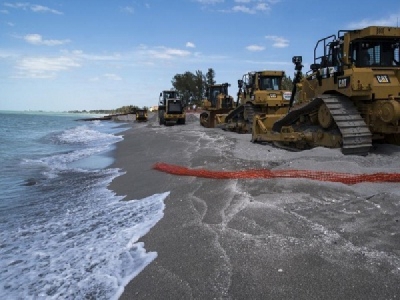
Posted on September 1, 2016
By Zach Murdock, Herald-Tribune
Local ties to World War II are costing Sarasota County an extra $1 million on a Siesta Key beach renourishment project that would have finished under budget otherwise.
The two-month effort to pump 713,000 cubic yards of sand — more than 1 million tons — to the Turtle Beach area from Palmer Point Park to the Sanderling Club seemingly went off without a hitch earlier this year. It finished on time and, originally, on its planned $21.5 million budget.
But, behind the scenes, the surprising discovery of decades-old ammunition in the sand being pulled from two areas miles offshore complicated and slowed the project from the beginning in early March, said county project manager Paul Semenec.
“We started Wednesday, (March) the 9th, and then by the 12th I started getting emails and phone calls from the contractor and their engineer because they had found some shell (casings) and bullets in the screen box they were using on the beach,” Semenc said this week.
That “screen box” at the end of contractor Weeks Marine’s dredge piping on the beach was supposed to catch any stray rocks too large to be sand.
Instead, it was catching dozens of corroded and rusted .50-caliber casings and roughly 3-inch-long bullets, Semenec said.
The ammunition likely traces back to Sarasota County’s days as a military training ground for U.S. Army pilots during World War II, although it’s impossible to prove that’s the source of the bullets and casings found this year, Semenec said.
At the time, the county was sparsely populated, so the Army established two air bases near the present-day Sarasota and Venice airports to train pilots on gunnery, firing and bombing ranges around the area, according to former county archivist Mark Smith, who has written extensively about the subject.
Pilots flying P-40 Kittyhawks and P-51 Mustangs — which each fired .50-caliber guns — practiced dive bombing and shooting at a range around Longboat Key, Smith has written.
The casings and bullets found by Weeks Marine came from sand borrow areas seven and 11 miles off the shore of south Siesta Key, but it’s probable that they are from those training days, Semenec said.
The U.S. Army Corps of Engineers, which oversees and permits beach renourishment projects, still classifies them as “munitions of explosive concern,” though. Once discovered, federal guidelines for handling the munitions had to be followed.
Weeks Marine also hired a munitions of explosive concern specialist based in Orlando to visit the project regularly to sift through its screen boxes for any munitions, Semenec said.
“It was done primarily for safety, because we didn’t know what we were going to be pulling up,” he said.
Weeks Marine installed another set of screens on the arms of its dredges that are lowered to the sea floor to further prevent pulling up ammunition, but those screens slowed production considerably, Weeks Marine argued in a claim filed with the county during the project.
About 150 casings and bullets were pulled from the dredge screens during the project, Semenec said.
Halfway through the work, Weeks Marine claimed the additional screens slowed work by 19.1 percent, costing the company more than $1.9 million, according to county documents. The company later dropped its claim to almost $1.6 million and negotiated further with county engineers until they agreed to a $1 million claim for loss of productivity.
The claim ate up the left over $332,000 remaining in the project budget once completed and pushed it another $668,000 over its planned budget, Semenec said.
The Sarasota County Commission unanimously approved that additional expense last week from the county’s tourist development tax fund.
Source: Herald-Tribune





